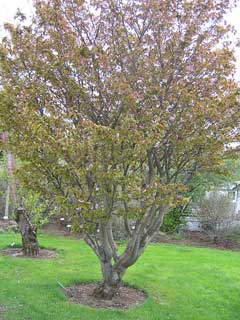
Japanese Alpine Cherry
Latin Name: Prunus nipponica
USDA Hardiness: 6-8
Native Range: TEMPERATE ASIA: Russian Federation (Kurile Islands, Sakhalin), Japan (Hokkaidô, Honshu)
Edibility Rating: 2 / 5
Medicinal Rating: 1 / 5
Region:
Family:
Plant Type:
Medicinal Uses
Edible Uses
Edible Parts: Fruit Seed | Edible Uses: Fruit - raw or cooked. Small[105, 177], it is about 8mm in diameter and contains one large seed[200]. Seed - raw or cooked. Do not eat the seed if it is too bitter - see the notes above on toxicity.
Cultivation
Landscape Uses:Specimen. Thrives in a well-drained moisture-retentive loamy soil, growing well on limestone[11, 200]. Prefers some lime in the soil but is likely to become chlorotic if too much lime is present[1]. Succeeds in sun or partial shade though it fruits better in a sunny position[11, 200]. Some named forms have been developed for their ornamental value[182]. Most members of this genus are shallow-rooted and will produce suckers if the roots are damaged[238]. Plants in this genus are notably susceptible to honey fungus[200]. Special Features:Attractive foliage, Not North American native, All or parts of this plant are poisonous, Blooms are very showy.
Known Hazards
Although no specific mention has been seen for this species, it belongs to a genus where most, if not all members of the genus produce hydrogen cyanide, a poison that gives almonds their characteristic flavour. This toxin is found mainly in the leaves and seed and is readily detected by its bitter taste. It is usually present in too small a quantity to do any harm but any very bitter seed or fruit should not be eaten. In small quantities, hydrogen cyanide has been shown to stimulate respiration and improve digestion, it is also claimed to be of benefit in the treatment of cancer. In excess, however, it can cause respiratory failure and even death.
Habitats
High mountains, C. and N. Japan[58].
